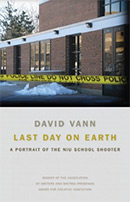Last Day on Earth: A Portrait of the NIU School Shooter

Authors: David Vann
Athens, GA: University of Georgia Press, 2011. 167p.
Reviewer: Rucha Tatke | September 2012
Last Day on Earth paints a troubled picture of Steven Kazmierczak, a sociology student at Northern Illinois University (NIU). An exceedingly intelligent individual bothered by a shaky psychological history, Kazmierczak’s issues culminated in a shooting on February 14, 2008, killing five and injuring twenty-one. Last Day on Earth is an intriguing read not only because it attempts to show some insight into a shooter’s mind, but also because the author, David Vann, looks to his own childhood as a parallel experience. Vann paints a somewhat brutal picture of his own life, one surrounded by guns and the love of hunting. Not only that, but he reflects on childhood experimentation with pipe bombs and BB guns. This delinquency is magnified in Steve Kazmierczak’s own experience. Vann attempts to understand Kazmierczak through a sympathetic perspective – one that works to a point. Foregoing the fear-mongering and sensationalizing of most media outlets, Vann really does paint a sympathetic portrait of this shooter.
The writing is at once methodical and confused. Vann tries to pursue Kazmierczak’s story in a chronological manner, but intersperses what he finds with narratives of his own experience. Initially this manner of writing makes it that much harder to differentiate between the two accounts, but this in fact ultimately works to Vann’s advantage. By drawing parallels, he shows that two similar beginnings could deviate significantly in their future trajectories. But then, what finally did trigger Kazmierczak’s homicidal run?
Vann takes great pains to show that Kazmierczak was a highly intelligent student, a dean’s lister, and much loved by the sociology faculty and students at NIU. He faced challenges like any other college student, deviating from his goals from time to time and wondering if his choice of major was the right one. But such confusion does not set him apart from his peers; in fact, he should have felt a kind of solidarity with them. From interviews with those in Kazmierczak’s life, Vann notes that the level of alienation and bitterness that he felt originated much earlier in his life. Vann isn’t afraid to dig deeper, showing that Kazmierczak had mental health issues and was on and off medication for years. His need for validation and companionship emerged in the seedier side of Craigslist, as he looked for sex online and would seemingly do anything to get it. Ultimately, finding like-minded girls almost seemed to encourage his racism, his love of horror and his fascination with the macabre. Vann painstakingly outlines this, and yet somehow manages to maintain his sympathetic point of view.
Vann also uses the narrative to question constitutional gun rights. Knowing that Kazmierczak was able to purchase guns despite his record, brings him to question why gun bans are still being overridden, and why the media spin is allowed to tell us that “Guns Save Lives.” Apart from the political overtones, Vann resists letting bias take over his account of Kazmierczak himself. He tries to understand Kazmierczak, almost as if he wants an explanation of why he himself did not go off the deep end. He lets his own experiences with contemplating suicide explain that those who go through with it seem to feel that it will help those they leave behind. As for Kazmierczak’s killing spree, Vann emphasizes that there were still many who loved the person they knew, and that despite the media’s attempts to erase that kind, loving, intelligent man, he existed somewhere beneath the troubled kid who wanted nothing more than to fit in.
Rucha Tatke, M.S. in Criminology, University of Pennsylvania ’12


